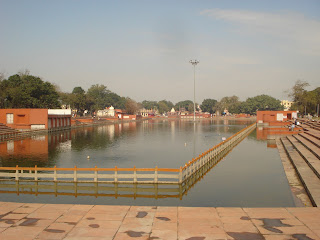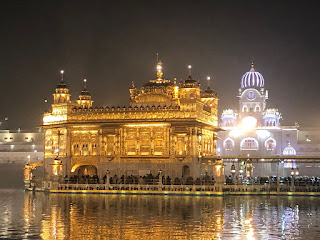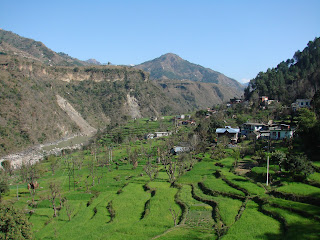Highways Beckon: Delhi - Manali Drive
The thrill of traveling across States by road is unparalleled, especially when add-ons and bonuses are thrown in. It is the first week of March. On impulse, we decide to drive to Manali from Delhi, a distance of 575 kms, very much do-able in a day. But being history buffs we stretch the drive to three days, zipping through some of the cities en route, and also digress a little to accommodate Amritsar.
In keeping with our practice of an early start while journeying long distance, we leave Delhi in the wee hours of the morning, well before the fiery planet casts his sober hue on the horizon, signaling the start of yet another day. Driving on relatively traffic-free roads, we soon hit NH-1. We head towards our first halt - Panipat or Panduprastha, founded by the legendary Pandavas of the epic Mahabharat fame. Pages from history come alive as I conjure images of bloodshed, of charging elephants and helmeted soldiers perched on horses swishing swords. My ears even ring with battle cries as I visualize the Lodhis, Mughuls, Marathas and Afghans engaged in bitter battles. Three wars happened here between 1526 and 1761 that changed the course of history and the fate of our country.
We enter the city through its famed Salarjung Gate and weave our way through dense traffic in the narrow lanes of the city to visit the seven hundred year old Dargah of Abu Ali Shah Qalandar Kala, the Sufi saint. From here we move to the outskirts of Panipat towards Kala Amb, meaning ‘black mango’ derived from a mango tree believed to have turned black due to the gruesome bloodshed that happened here.
We stand in front of a mural commemorating the First Battle of Panipat at Kala Amb, a spot now cloaked in silence and serenity. We leave this beautifully landscaped and tree-lined lawn with its pillars and murals to visit the Tomb of Ibrahim Lodhi and Kabuli Bagh with its lush garden, tank and mosque, named for Babur’s wife Mussammat Kabuli Begum, built to commemorate Babur’s victory over Ibrahim Lodhi. We are now ready to leave Panipat, but not before partaking of a heavy breakfast of spicy parathas with panchranga pickle, washed down with thick hot milk and jalebis.
The sun is obscured by a heavy drape of mist as we near Karnal, founded by Karna, yet another legend associated with the Mahabharat. We ignore the white veil and continue to explore Karnal, a city that came out of obscurity in 1739, with the victory of Nadir Shah over Mohammad Shah. We head first, towards Karna Taal, an erstwhile lake, now run bone dry. Except for an ASI board and a memorial pillar at one end of a dilapidated area, there is nothing to indicate its former glory or significance.
We are disappointed at the visit but continue to the other sites that include the Tomb of Abu Ali Qalandar, Miran Sahib’s Tomb – built in memory of a saint who is believed to have rescued a brahmin girl from the clutches of a Hindu king in a pitched battle, and Gurudwara Manji Sahib that commemorates the meeting of Qalander Shah and Guru Nanak.
We wind up Karnal with a visit to its lake, the mist deciding to be a killjoy.
It is early afternoon when we reach Kurukshetra, a city where history breathes and legends come alive. Following lunch at Haveli, we spend the afternoon and evening visiting the various sites associated with the Mahabharat, taking the assistance of guide Mahesh. Bhadra kali Mandir where the Pandavas performed austerities and rituals before their final battle against the Kauravas, the Bhishma Kund where Arjuna is believed to have shot an arrow towards the earth to quench the thirst of Bhishma,
the Brahma Sarovar where pilgrims throng to have a holy dip during Somvati Amavasya, Jyotisar – Kurukshetra’s most revered site, housing the Vat or Banyan tree under which Lord Krishna is believed to have delivered the message of the Bhagavad Gita to Arjun, the Sthaneshwar Mandir where the Pandavas prayed to Shiva and sought his blessings for victory in the Battle of Mahabharat, and finally, the Sannihit Sarovar considered the holy abode of Vishnu. Mahesh tells us that a dip in its holy waters, especially on Amavasya or on an eclipse day would bestow upon us blessings obtained by performing the Ashwamedha Yajna!
We give the Kurukshetra Panorama and Science Centre and the Kalpana Chawla Planetarium a skip for lack of time. But we do manage an hour at Sheikh Chehli’s Tomb before hitting the road to Ambala, a distance of 45 km from Kurukshetra. Made of buff sandstone and marble, the tomb is a beautiful medieval monument reflecting Persian architectural style, containing the mortal remains of the Sufi Saint Abdur Rahim, popularly known as Sheikh Chehli. He was supposedly the spiritual guru of Dara Shikoh, the Mughal prince and son of Shah Jehan. An ASI- declared Heritage Monument, its expansive precincts with several structures looks regal even in ruins.
On the highway between Kurukshetra and Ambala, we make a brief halt at the Temple of Markhandeya before proceeding to Ambala.
At Ambala we make few photo stops at select landmarks in the city including the Manji Sahib and Panjokhra Sahib Gurudwaras, St.Paul’s, the city’s oldest church now in ruins, thanks to bombings during the Indo-Pak war of 1965. We drive onward to Ludhiana for the night halt.
We enter Amritsar as the first rays of the rising star douses the dome of Harmandir Sahib in its pastel glow. The chorus singing of kirtans is soothing to the senses and despite the continuous flow of pilgrims, there is a kind of tranquility that can best be described as a spiritual feeling defying description. We pay obeisance to the Holy Granth, partake of the prasad and walk through the city’s bustling and colourful lanes.
A few hundred meters from the Golden Temple, we enter the grounds of Jallianwala Bagh, a silent ode to hundreds of innocent lives lost to the gun fire of General Dyer on 13 April 1919. The now-serene area, is a tragic reminder of the massacre when hapless victims jumped to their deaths into the well which is situated in a corner of the well-manicured garden. As if to efface the memory of the blood and gore the place witnessed, Jallianwala Bagh is plush precincts today with abounding flowers, lush lawns and laughter from a group that is practicing the therapy here.
Durgiana Temple – the Golden Temple-look-alike is next on our agenda after which we hit the road to Wagah Border. Following a very satisfying peek at the change of guards, we continue our onward journey to Bhakra Nangal, but not before stopping for a shot of the Dogri War Memorial in the outskirts of Amritsar.
Since no photography is allowed at Bhakra or Nangal, I satisfy myself with shots of a haat in progress near Nangal. The crystal clear waters beckon us to spend a while savouring their glassy beauty before we make our way to Anandpur Sahib, passing rocky and rugged mountain terrain.
At several places along the way, we are mesmerized by nature’s own sculptural handiwork on the rock faces. The hilltop temple of Naina Devi follows Anandpur Sahib and then it is a nonstop drive up to Hilltop Hotel, Swaarghat for the night stay.

The brilliant
weather throughout our trip keeps our spirits and physical state buoyed without
the slightest hint of weariness despite the packed itineraries. We follow the serpentine path of Gobind Sagar Lake
through to Bilaspur.
We visit its Vyas Gufa – the cave where Ved Vyas began to
compose the epic Mahabharat.
A slight deviation from our route brings us to the 285m long Kandror Bridge, an engineering feat of marvel considered Asia’s highest bridge of its kind. The shutterbug in me is inspired by the scenic surrounds at Sundarnagar Valley with the backdrop of snow clad mountain ranges against the dam and waterways. It is early afternoon when we pass the temple town of Mandi, soaked in a profusion of colours with ongoing Shivratri celebrations. We snake our way through a maze of traffic as endless processions of devotees carrying idols of deities make merry to the beat of folk instruments. A little close to twilight, we reach Manali uneventfully, passing through, Kullu and Raisson which we plan to visit at leisure during our three-day stay in Manali.
Being Timeshare
holders with Sterling Resorts, we are booked there, at Prini, 3km from the old
town of Manali. We have a room with view – a stunning one, of the snow-capped
mountains, the slopes of which are dotted with little village dwellings. At the end of a scintillating three-day drive from Delhi, our spiritual senses are sated and we brace ourselves to roll yet again, traversing the roads of Himachal.

























































No comments:
Post a Comment